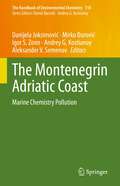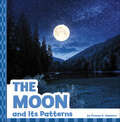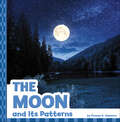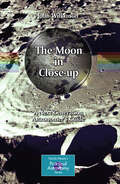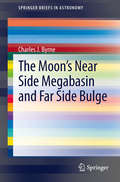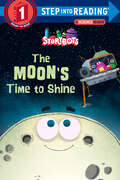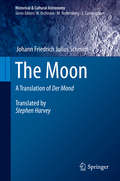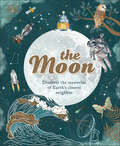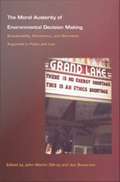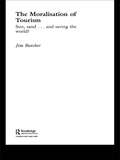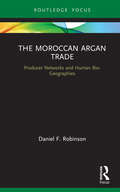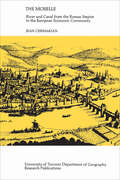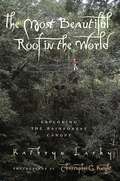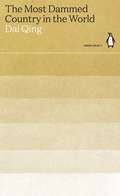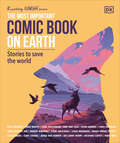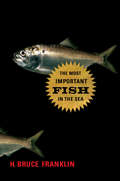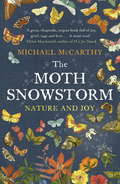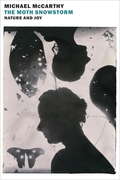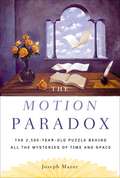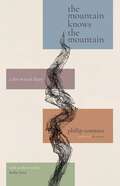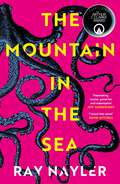- Table View
- List View
The Montenegrin Adriatic Coast: Marine Chemistry Pollution (The Handbook of Environmental Chemistry #110)
by Andrey G. Kostianoy Igor S. Zonn Aleksander V. Semenov Mirko Đurović Danijela JoksimovićThis is the second of two volumes that together provide an integrated picture of the Montenegrin Adriatic coast, presenting the natural components of the system as well as the chemical composition and chemical processes in the extended area. This book covers all aspects of marine chemistry such as the hydrographic and oceanographic characteristics of seawater, the toxicity of heavy metals in the marine environment, the quality of marinas and maritime areas, and the legal regime for protecting the marine environment from pollution. Given the breadth and depth of its coverage, the book offers an invaluable source of information for researchers, students and environmental managers alike.
The Moon Seems to Change (Let's-Read-and-Find-Out Science 2)
by Dr. Franklyn M. BranleyRead and find out about the phases of the moon in this colorfully illustrated nonfiction picture book.This clear and appealing science book for early elementary age kids, both at home and in the classroom, introduces basic information about the moon.Have you noticed that the moon sometimes seems to grow and shrink? Does it look like a big round ball? Or is it just a sliver of light in the sky? The moon seems to change. But it doesn't really. The moon revolves around the Earth. It takes about four weeks to make the journey, and as it travels around we can only see certain parts of it. Try the simple experiment described inside using an orange, a pencil, and a flashlight, and you'll understand why the moon seems to change.This is a Level 2 Let's-Read-and-Find-Out, which means the book explores more challenging concepts for children in the primary grades. The 100+ titles in this leading nonfiction series are:hands-on and visualacclaimed and trustedgreat for classroomsTop 10 reasons to love LRFOs:Entertain and educate at the same timeHave appealing, child-centered topicsDevelopmentally appropriate for emerging readersFocused; answering questions instead of using survey approachEmploy engaging picture book quality illustrationsUse simple charts and graphics to improve visual literacy skillsFeature hands-on activities to engage young scientistsMeet national science education standardsWritten/illustrated by award-winning authors/illustrators & vetted by an expert in the fieldOver 130 titles in print, meeting a wide range of kids' scientific interestsBooks in this series support the Common Core Learning Standards, Next Generation Science Standards, and the Science, Technology, Engineering, and Math (STEM) standards. Let's-Read-and-Find-Out is the winner of the American Association for the Advancement of Science/Subaru Science Books & Films Prize for Outstanding Science Series.
The Moon and Its Patterns (Patterns in the Sky)
by Thomas K. AdamsonWhat is the moon? Why do we see it at night? And why does it seem to change shape? Learn the answers to these questions and more in this easy-to-read title and discover the science behind the moon and its patterns.
The Moon and Its Patterns (Patterns in the Sky)
by Thomas K. AdamsonWhat is the moon? Why do we see it at night? And why does it seem to change shape? Learn the answers to these questions and more in this easy-to-read title and discover the science behind the moon and its patterns.
The Moon in Close-up
by John WilkinsonInformation collected by recent space probes sent to explore the Moon by the USA, the European Space Agency, Japan, China and India has changed our knowledge and understanding of the Moon, particularly its geology, since the Apollo missions. This book presents those findings in a way that will be welcomed by amateur astronomers, students, educators and anyone interested in the Moon. Enhanced by many colour photos, it combines newly acquired scientific understanding with detailed descriptions and labelled photographic maps of the lunar surface. Guided by observation methods explained in the book and 17 Study Areas presented and carefully explained in the last chapter, amateur astronomers can observe these features from Earth using telescopes and binoculars. Readers who consult the photographic maps will gain a better understanding about the Moon's topography and geology. The book is rounded out by a helpful glossary.
The Moon of the Wild Pigs (Thirteen Moons)
by Jean Craighead GeorgeDescribes animal and plant life in the drought-parched desert during the month of July and how a little wild pig adapts to this environment. Includes image descriptions.
The Moon's Near Side Megabasin and Far Side Bulge
by Charles ByrneSince Luna and Lunar Orbiter photographed the far side of the Moon, the mysterious dichotomy between the face of the Moon as we see it from Earth and the side of the Moon that is hidden has puzzled lunar scientists. As we learned more from the Apollo sample return missions and later robotic satellites, the puzzle literally deepened, showing asymmetry of the crust and mantle, all the way to the core of the Moon. This book summarizes the author's successful search for an ancient impact feature, the Near Side Megabasin of the Moon and the extensions to impact theory needed to find it. The implications of this ancient event are developed to answer many of the questions about the history of the Moon.
The Moon's Time to Shine (Step into Reading)
by StorybotsJust in time for the 50th anniversary of the moon landing! The inquisitive crew from the award-winning StoryBots apps, videos, and Emmy Award-winning Netflix show star in a Step 1 reader that is over the moon!Children will recognize the signature catchy rhymes and colorful art from the StoryBots' popular YouTube video "The Moon's Time to Shine." They will learn that the moon orbits Earth, that--in spite of glowing brightly--it doesn't make its own light, and more! Step 1 readers feature big type and easy words for children who know the alphabet and are eager to begin reading. Rhyming text is paired with picture clues to help children decode the story.
The Moon: A Translation of Der Mond (Historical & Cultural Astronomy)
by Johann Friedrich SchmidtJulius Schmidt was one of the finest astronomical observers of his time, and his detailed map of the Moon surpassed anything that had come before. Today, the German astronomer and geophysicist has remained a largely neglected figure, despite being one of the most important players in the history of lunar studies. This book at last makes accessible Schmidt’s highly regarded German work, Der Mond. Considered an astronomical classic of the nineteenth century, Der Mond remained without a proper English counterpart for the last century and a half, until now. The author’s faithful English translation provides readers with much-needed access into Schmidt’s original publication, with the aim of showing the community just how vital his work and legacy have been in the international field of selenography.
The Moon: Discover the Mysteries of Earth's Closest Neighbour (Space Explorers)
by Dr. Sanlyn Buxner Pamela Gay Georgiana KramerDiscover the mysteries of Earth&’s closest neighbor in this incredible guide to the Moon. This charming book is the perfect introduction for young readers who want to learn about every aspect of the moon. The Moon features breakdowns of the Moon&’s formation and geography, the lunar phases, a history of NASA&’s Apollo missions, the Moon&’s effect on Earth&’s tides and nocturnal animals, recent scientific discoveries, and so much more!This fascinating guide introduces 7-9 year olds to the moon&’s past, present, and future, through stunning illustrations, photographs, and fascinating information. Packed with mind-blowing facts, this incredible book of the moon is perfect for space lovers everywhere. Explore this wonderful book about the moon, featuring:- In-depth information, backed up by space photography, probe images, illustrations, and fun diagrams- Stunning, dreamy illustrations, making this title a perfect gift, as well as a solid reference book - Easy-to-digest sections, each filled with incredible facts and visuals- The entire subject of the Moon – including its formation and geography, the lunar phases, a history of NASA&’s Apollo missions, its effect on Earth&’s tides and nocturnal animals, plenty of recent scientific discoveries, and more!Boasting beautiful illustrations by artist Dawn Cooper, combined with up-to-date images from space agencies such as NASA and ESA, info panels, timelines, and diagrams, that help demystify and explain the wonder of the Moon, this is the perfect book for young readers.
The Moral Austerity of Environmental Decision Making: Sustainability, Democracy, and Normative Argument in Policy and Law
by John Martin Gillroy Joe BowersoxIn The Moral Austerity of Environmental Decision Making a group of prominent environmental ethicists, policy analysts, political theorists, and legal experts challenges the dominating influence of market principles and assumptions on the formulation of environmental policy. Emphasizing the concept of sustainability and the centrality of moral deliberation to democracy, they examine the possibilities for a wider variety of moral principles to play an active role in defining "good" environmental decisions. If environmental policy is to be responsible to humanity and to nature in the twenty-first century, they argue, it is imperative that the discourse acknowledge and integrate additional normative assumptions and principles other than those endorsed by the market paradigm. The contributors search for these assumptions and principles in short arguments and debates over the role of science, social justice, instrumental value, and intrinsic value in contemporary environmental policy. In their discussion of moral alternatives to enrich environmental decision making and in their search for a less austere and more robust role for normative discourse in practical policy making, they analyze a series of original case studies that deal with environmental sustainability and natural resources policy including pollution, land use, environmental law, globalism, and public lands. The unique structure of the book--which features the core contributors responding in a discourse format to the central chapters' essays and debates--helps to highlight the role personal and public values play in democratic decision making generally and in the field of environmental politics specifically. Contributors. Joe Bowersox, David Brower, Susan Buck, Celia Campbell-Mohn, John Martin Gillroy, Joel Kassiola, Jan Laitos, William Lowry, Bryan Norton, Robert Paehlke, Barry G. Rabe, Mark Sagoff, Anna K. Schwab, Bob Pepperman Taylor, Jonathan Wiener
The Moral Challenge of Dangerous Climate Change
by Darrel MoellendorfThis book examines the threat that climate change poses to the projects of poverty eradication, sustainable development, and biodiversity preservation. It offers a careful discussion of the values that support these projects and a critical evaluation of the normative bases of climate change policy. This book regards climate change policy as a public problem that normative philosophy can shed light on. It assumes that the development of policy should be based on values regarding what is important to respect, preserve, and protect. What sort of climate change policy do we owe the poor of the world who are particularly vulnerable to climate change? Why should our generation take on the burden of mitigating climate change that is caused, in no small part, by emissions from people now dead? What value is lost when natural species go extinct, as they may well do en masse because of climate change? This book presents a broad and inclusive discussion of climate change policy, relevant to those with interests in public policy, development studies, environmental studies, political theory, and moral and political philosophy.
The Moralisation of Tourism: Sun, Sand... and Saving the World? (Contemporary Geographies of Leisure, Tourism and Mobility)
by Jim ButcherTourism is no longer an innocent pleasure. It has been interpreted and reinterpreted as an activity which is ultimately damaging to receiving cultures and the environment. 'New' forms of tourism, such as ecotourism, alternative tourism, community tourism and ethical tourism, have been presented as morally superior alternatives to the package holiday, yet ironically, even advocates of these new, ethical tourism brands are increasingly subject to criticisms, not dissimilar to those they themselves level against package holidays. Using a host of international examples from the industry, the media and non-governmental organisations, this intriguing book examines what the advocates of 'new tourism' see as being wrong with mass tourism, looks critically at the claims made for the new alternatives and makes a case for guilt-free holidays. The only book on the market to provide a sustained critique of conventional mass tourism’s own critics, Butcher offers a counterpoint to the moral rhetoric steadily turning travellers into guilty tourists.
The Moroccan Argan Trade: Producer Networks and Human Bio-Geographies (Earthscan Studies in Natural Resource Management)
by Daniel F. RobinsonThis book provides one of the most detailed and comprehensive examinations of the Moroccan argan tree, the products derived from it and its cultural significance. The Moroccan argan trade is booming, but as the tree provides important ecological functions and plays an important role, both financially and culturally, for the Amazigh (Berber) people it has become a key topic of debate. This book thoroughly examines the production stories, benefits and impacts and provides a value-chain analysis which compares different cooperatives and approaches to production. It assesses the fair-trade approaches and attempts at sustainable production of the bio-trade resource. While being a vital source of income, the argan tree has a significant cultural importance to the Indigenous people and the book assesses the impact of the argan trade on their well-being, community and livelihoods. It examines Indigenous knowledge and intellectual property issues relating to the trade, as well as Berber-state law and politics. Assessing factors relating to legal and economic geography international trade, socio-cultural and human-nature relationships, the book provides a comprehensive analysis of the argan tree which will appeal to students, scholars and practitioners.
The Moselle: River and Canal from the Roman Empire to the European Economic Community
by Jean CermakianThe Moselle has been one of the main arteries of European Communication and transportation for centuries. The Romans used it as a main thoroughfare from southern to northern Europe and also began the improvements to its navigation that have continued intermittently through the industrial revolution to the present day. Professor Cermakian focuses on the historical, political, and geographical factors in the use and canalization of this international river – a focus that is derived from his interest in the details of standardizing transport networks and policy as an important part of 'European integration,' which he sees both as a long historical movement and as a present endeavour under EEC. The book offers a history of the political economy of an important river, a symbol for many of the spirit of Europe.(University of Toronto Department of Geography Research Publications 14)
The Most Beautiful Roof in the World: Exploring the Rainforest Canopy
by Kathryn LaskyJourney along with Dr. Meg Lowman, a scientist who, with the help of slings, suspended walkways, and mountain-climbing equipment, has managed to ascend into one of our planet’s least accessible and most fascinating ecosystems--the rain-forest canopy. “Fresh in outlook and intriguing in details, this book will strengthen any library collection on the rainforest. ”--Booklist
The Most Dammed Country in the World (Green Ideas)
by Dai QingIn twenty short books, Penguin brings you the classics of the environmental movement.The courageous, unflinching speeches and writings collected in The Most Dammed Country in the World detail the devastating human and environmental cost of China's economic rise.Over the past 75 years, a new canon has emerged. As life on Earth has become irrevocably altered by humans, visionary thinkers around the world have raised their voices to defend the planet, and affirm our place at the heart of its restoration. Their words have endured through the decades, becoming the classics of a movement. Together, these books show the richness of environmental thought, and point the way to a fairer, saner, greener world.
The Most Important Comic Book on Earth: Stories to Save the World
by Jane Goodall Scott Snyder Cara Delevingne Ricky Gervais Taika Waititi120 inspiring visual stories on environmentalism from key figures, charities, activists, and artists. The Most Important Comic Book On Earth is a global collaboration for planetary change, bringing together a diverse team of 300 leading environmentalists, artists, authors, actors, filmmakers, musicians, and more to present over 120 stories to save the world. Whether it&’s inspirational tales from celebrity names such as Cara Delevingne and Andy Serkis, hilarious webcomics from War and Peas and Ricky Gervais, artworks by leading illustrators David Mack and Tula Lotay, calls to action from activists George Monbiot and Jane Goodall, or powerful stories by Brian Azzarello and Amy Chu, each of the comics in this anthology will support projects and organizations fighting to save the planet and Rewrite Extinction.
The Most Important Fish in the Sea: Menhaden and America
by H. Bruce FranklinIn this brilliant portrait of the oceans' unlikely hero, H. Bruce Franklin shows how menhaden have shaped America's national--and natural--history, and why reckless overfishing now threatens their place in both. Since Native Americans began using menhaden as fertilizer, this amazing fish has greased the wheels of U.S. agriculture and industry. By the mid-1870s, menhaden had replaced whales as a principal source of industrial lubricant, with hundreds of ships and dozens of factories along the eastern seaboard working feverishly to produce fish oil. Since the Civil War, menhaden have provided the largest catch of any American fishery. Today, one company--Omega Protein--has a monopoly on the menhaden "reduction industry." Every year it sweeps billions of fish from the sea, grinds them up, and turns them into animal feed, fertilizer, and oil used in everything from linoleum to health-food supplements. The massive harvest wouldn't be such a problem if menhaden were only good for making lipstick and soap. But they are crucial to the diet of bigger fish and they filter the waters of the Atlantic and Gulf coasts, playing an essential dual role in marine ecology perhaps unmatched anywhere on the planet. As their numbers have plummeted, fish and birds dependent on them have been decimatedand toxic algae have begun to choke our bays and seas. In Franklin's vibrant prose, the decline of a once ubiquitous fish becomes an adventure story, an exploration of the U.S. political economy, a groundbreaking history of America's emerging ecological consciousness, and an inspiring vision of a growing alliance between environmentalists and recreational anglers.
The Moth Snowstorm: Nature and Joy
by Michael McCarthyA great, rhapsodic, urgent book full of joy, grief, rage and love . . . A must-read' Helen Macdonald, author of H is for HawkNature has many gifts for us, but perhaps the greatest of them all is joy; the intense delight we can take in the natural world, in its beauty, in the wonder it can offer us, in the peace it can provide - feelings stemming ultimately from our own unbreakable links to nature, which mean that we cannot be fully human if we are separate from it. In The Moth Snowstorm Michael McCarthy, one of Britain's leading writers on the environment, proposes this joy as a defence of a natural world which is ever more threatened, and which, he argues, is inadequately served by the two defences put forward hitherto: sustainable development and the recognition of ecosystem services.Drawing on a wealth of memorable experiences from a lifetime of watching and thinking about wildlife and natural landscapes, The Moth Snowstorm not only presents a new way of looking at the world around us, but effortlessly blends with it a remarkable and moving memoir of childhood trauma from which love of the natural world emerged. It is a powerful, timely, and wholly original book which comes at a time when nature has never needed it more.
The Moth Snowstorm: Nature and Joy
by Michael McCarthyA great, rhapsodic, urgent book full of joy, grief, rage and love . . . A must-read' Helen Macdonald, author of H is for HawkNature has many gifts for us, but perhaps the greatest of them all is joy; the intense delight we can take in the natural world, in its beauty, in the wonder it can offer us, in the peace it can provide - feelings stemming ultimately from our own unbreakable links to nature, which mean that we cannot be fully human if we are separate from it. In The Moth Snowstorm Michael McCarthy, one of Britain's leading writers on the environment, proposes this joy as a defence of a natural world which is ever more threatened, and which, he argues, is inadequately served by the two defences put forward hitherto: sustainable development and the recognition of ecosystem services.Drawing on a wealth of memorable experiences from a lifetime of watching and thinking about wildlife and natural landscapes, The Moth Snowstorm not only presents a new way of looking at the world around us, but effortlessly blends with it a remarkable and moving memoir of childhood trauma from which love of the natural world emerged. It is a powerful, timely, and wholly original book which comes at a time when nature has never needed it more.
The Moth Snowstorm: Nature and Joy
by Michael MccarthyThe moth snowstorm, a phenomenon Michael McCarthy remembers from his boyhood when moths "would pack a car's headlight beams like snowflakes in a blizzard," is a distant memory. Wildlife is being lost, not only in the wholesale extinctions of species but also in the dwindling of those species that still exist.The Moth Snowstorm is unlike any other book about climate change today; combining the personal with the polemical, it is a manifesto rooted in experience, a poignant memoir of the author's first love: nature. McCarthy traces his adoration of the natural world to when he was seven, when the discovery of butterflies and birds brought sudden joy to a boy whose mother had just been hospitalized and whose family life was deteriorating. He goes on to record in painful detail the rapid dissolution of nature's abundance in the intervening decades, and he proposes a radical solution to our current problem: that we each recognize in ourselves the capacity to love the natural world.Arguing that neither sustainable development nor ecosystem services have provided adequate defense against pollution, habitat destruction, species degradation, and climate change, McCarthy asks us to consider nature as an intrinsic good and an emotional and spiritual resource, capable of inspiring joy, wonder, and even love. An award-winning environmental journalist, McCarthy presents a clear, well-documented picture of what he calls "the great thinning" around the world, while interweaving the story of his own early discovery of the wilderness and a childhood saved by nature. Drawing on the truths of poets, the studies of scientists, and the author's long experience in the field, The Moth Snowstorm is part elegy, part ode, and part argument, resulting in a passionate call to action.
The Motion Paradox
by Joseph MazurThe epic tale of an ancient, unsolved puzzle and how it relates to all scientific attempts to explain the basic structure of the universe At the dawn of science the ancient Greek philosopher Zeno formulated his paradox of motion, and amazingly, it is still on the cutting edge of all investigations into the fabric of reality. Zeno used logic to argue that motion is impossible, and at the heart of his maddening puzzle is the nature of space and time. Is space-time continuous or broken up like a string of beads? Over the past two millennia, many of our greatest minds-including Aristotle, Galileo, Newton, Einstein, Stephen Hawking, and other current theoreticians-have been gripped by the mystery this puzzle represents. Joseph Mazur, acclaimed author of Euclid in the Rainforest, shows how historic breakthroughs in our understanding of motion shed light on Zeno's paradox. The orbits of the planets were explained, the laws of motion were revealed, the theory of relativity was discovered-but the basic structure of time and space remained elusive. In the tradition of Fermat's Enigma and Zero, The Motion Paradox is a lively history of this apparently simple puzzle whose solution-if indeed it can be solved-will reveal nothing less than the fundamental nature of reality.
The Mountain Knows the Mountain: A Fire Watch Diary
by Philip ConnorsA poignant and ruminative work of creative nonfiction by the bestselling, National Outdoor Book Award-winning author of Fire Season. The Mountain Knows the Mountain tells the story of the writer's return to the Gila Wilderness for fire season after missign a year for multiple surgeries. Reminscent in spirit and lyricism to great works from Peter Matthiesen, Terry Tempest Williams, Barry Lopez, and Norman MacLean.Multi-award-winning writer Philip Connors had been a fire watcher in the Gila Wilderness for fourteen straight summers when he sustained an injury and was forced to miss a year recovering. When he returned, he resolved to see the mountain with fresh eyes and to keep a detailed notebook.The result is The Mountain Knows the Mountain, a meticulously observed experience of one fire season chronicled in haibun, the centuries-old prose form dating from Basho&’s Narrow Road to the Interior that recounts both inner and outer journeys and incorporates traditional haiku as an occasional element of narrative counterpoint. Though only a beginner in the practice of haiku, Connors deftly weaves close observation, personal reflection, and memory with hard-won knowledge of the forest, of the mountain, and of fire.The Mountain Knows the Mountain is both mythic and immediate, a chronicle of daily events granular in their specificity but connected to larger themes of the observed world and the inner life of the observer. Connors captures the various moods of a long season on a mountain; plays with language and ways of seeing; and includes contributing perspectives from his partner, Mónica Ortiz Uribe, and his friend the late editor and publisher Bobby Byrd. Together with the author&’s own simple drawings, the resulting snapshots offer incisive visions of how to be intimate with the wild.
The Mountain in the Sea
by Ray Nayler'I loved this novel's brain and heart'DAVID MITCHELL, AUTHOR OF CLOUD ATLAS'A first-rate speculative thriller, by turns fascinating, brutal, powerful, and redemptive'JEFF VANDERMEER, AUTHOR OF ANNIHILATIONThere are creatures in the water of Con Dao. To the locals, they're monsters. To the corporate owners of the island, an opportunity. To the team of three sent to study them, a revelation. Their minds are unlike ours. Their bodies are malleable, transformable, shifting. They can communicate. And they want us to leave.When pioneering marine biologist Dr. Ha Nguyen is offered the chance to travel to the remote Con Dao Archipelago to investigate a highly intelligent, dangerous octopus species, she doesn't pause long enough to look at the fine print. DIANIMA- a transnational tech corporation best known for its groundbreaking work in artificial intelligence - has purchased the islands, evacuated their population and sealed the archipelago off from the world so that Nguyen can focus on her research.But the stakes are high: the octopuses hold the key to unprecedented breakthroughs in extrahuman intelligence and there are vast fortunes to be made by whoever can take advantage of their advancements. And no one has yet asked the octopuses what they think. And what they might do about it.
